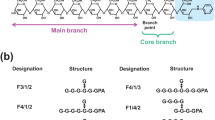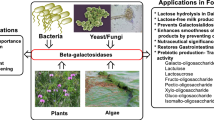Abstract
The present study focuses on characterization of two hemicellulases, RuXyn1 and RuXyn2, from rumen bacterial metagenome and their capabilities for degradation of xylans. Glycosyl hydrolase (GH) family 43 β-d-xylosidase/α-l-arabinofuranosidase RuXyn1 can hydrolyze p-nitrophenyl-β-d-xylopyranoside (pNPX), p-nitrophenyl-α-l-arabinofuranoside (pNPA), and xylo-oligosaccharide substrates, while GH30 1,5-α-l-arabinofuranosidase/β-d-xylosidase RuXyn2, the first α-l-arabinofuranosidase assigned to this GH family, shows activities towards 1,5-α-l-arabinobiose and pNPX substrates but no activity for pNPA. Kinetic analysis for aryl-glycosides revealed that RuXyn2 had higher catalytic efficiency than RuXyn1 toward pNPX substrate. RuXyn1 shows high synergism with endoxylanase, elevating by 73% the reducing sugars released from brichwood xylans, and converted most intermediate xylo-oligosaccharide hydrolysate into xylose. The high xylose conversion capability of RuXyn1 suggests it has potential applications in enzymatic production of xylose and improvement of hemicellulose saccharification for production of biofuels. RuXyn2 shows no obviously synergistic effect in the endoxylanase-coupled assay for enzymatic saccharification of xylan. Further cosmid DNA sequencing revealed a neighboring putative GH43 α-l-arabinofuranosidase RuAra1 and two putative GH3 β-xylosidase/arabinosidases, RuXyn3 and RuXyn5, downstream of RuXyn2, indicating that this hemicellulase gene cluster may be responsible for production of end-product, xylose and arabinose, from hemicellulose biomass.








Similar content being viewed by others
References
An D, Dong XZ, Dong ZY (2005) Prokaryote diversity in the rumen of yak (Bos grunniens) and Jinnan cattle (Bos taurus) estimated by 16S rDNA homology analyses. Anaerobe 11:207–215
Beg QK, Kapoor M, Mahajan L, Hoondal GS (2001) Microbial xylanases and their industrial applications: a review. Appl Microbiol Biotechnol 56:326–338
Bradford MM (1976) A rapid and sensitive method for the quantitation of microgram quantities of protein utilizing the principle of protein-dye binding. Anal Biochem 72:248–254
Buck GE, O’Hara LC, Summersgill JT (1992) Rapid simple method for treating clinical specimens containing Mycobacterium tuberculosis to remove DNA for polymerase chain reaction. J Clin Microbiol 30:1331–1334
Coughlan MP, Hazlewood GP (1993) Beta-1, 4-d-xylan-degrading enzyme systems: biochemistry, molecular biology and applications. Biotechnol Appl Biochem 17:259–289
Dehority BA (1991) Effects of microbial synergism on fibre digestion in the rumen. Proc Nutr Soc 50:149–159
Engel PC (1981) Enzyme kinetics: the steady-state approach, 2nd edn. Chapman and Hall, London, pp 26–36
Henrissat B, Callebaut I, Fabrega S, Lehn P, Mornon JP, Davies G (1995) Conserved catalytic machinery and the prediction of a common fold for several families of glycosyl hydrolases. Proc Natl Acad Sci USA 92:7090–7094
Honda Y, Fushinobu S, Hidaka M, Wakagi T, Shoun H, Taniguchi H, Kitaoka M (2008) Alternative strategy for converting an inverting glycoside hydrolase into a glycosynthase. Glycobiology 18:325–330
Huang LN, Hseu TH, Lee YJ (1995) EMBL database submission accession no. U38661. http://www.ebi.ac.uk/cgi-bin/emblfetch?style=html&id=U38661&Submit=Go
Jordan DB, Li XL (2007) Variation in relative substrate specificity of bifunctional beta-d-xylosidase/alpha-l-arabinofuranosidase by single site mutations: roles of substrate distortion and recognition. Biochim Biophys Acta 1774:1192–1198
Krause DO, Denmana SE, Mackiec RI, Morrisond M, Raea AL, Attwoode GT, McSweeneya CS (2003) Opportunities to improve fiber degradation in the rumen: microbiology, ecology, and genomics. FEMS Microbiol Rev 27:663–693
Laemmli UK (1970) Cleavage of structural proteins during the assembly of the head of bacteriophage T4. Nature 227:680–685
Lee RC, Hrmova M, Burton RA, Lahnstein J, Fincher GB (2003) Bifunctional family 3 glycoside hydrolases from barley with alpha-l-arabinofuranosidase and beta-d-xylosidase activity. Characterization, primary structures, and COOH-terminal processing. J Biol Chem 278:5377–5387
Lineweaver H, Burk D (1934) The determination of enzyme dissociation constants. J Am Chem Soc 56:658–666
Liu JR, Yu B, Lin SH, Cheng KJ, Chen YC (2005) Direct cloning of a xylanase gene from the mixed genomic DNA of rumen fungi and its expression in intestinal Lactobacillus reuteri. FEMS Microbiol Lett 251:233–241
Mai V, Wiegel J, Lorenz WW (2000) Cloning, sequencing, and characterization of the bifunctional xylosidase/arabinosidase from the anaerobic thermophile Thermoanaerobacter ethanolicus. Gene 247:137–143
Miller GL (1959) Use of dinitrosalicylic acid reagent for determination of reducing sugar. Anal Chem 31:426–428
Nummi M, Perrin JM, Niku-Paavola ML, Enari TM (1985) Measurement of xylanase activity with insoluble substrate. Biochem J 226:611–620
Saitou N, Nei M (1987) The neighbor-joining method: a new method for reconstructing phylogenetic trees. Mol Biol Evol 4:406–425
Shallom D, Shoham Y (2003) Microbial hemicellulases. Curr Opin Microbiol 6:219–228
Shin HY, Lee JH, Lee JY, Han YO, Han MJ, Kim DH (2003) Purification and charaterization of ginsenoside Ra-hydrolyzing beta-d-Xylosidase from Bifidobacterium breve K-110, a human intestinal anaerobic bacterium. Biol Pharm Bull 26:1170–1173
St John FJ, González JM, Pozharski E (2010) Consolidation of glycosyl hydrolase family 30: a dual domain 4/7 hydrolase family consisting of two structurally distinct groups. FEBS Lett 584:4435–4441
Streit WR, Schmitz RA (2004) Metagenomics—the key to the uncultured microbes. Curr Opin Microbiol 7:492–498
Wagschal K, Heng C, Lee CC, Robertson GH, Orts WJ, Wong DW (2009) Purification and characterization of a glycoside hydrolase family 43 beta-xylosidase from Geobacillus thermoleovorans IT-08. Appl Biochem Biotechnol 155:1–10
Wagschal K, Heng C, Lee CC, Wong DWS (2009) Biochemical characterization of a novel dual-function arabinofuranosidase/xylosidase isolated from a compost starter mixture. Appl Microbiol Biotechnol 81:855–863
Wilkie KCB (1979) The hemicelluloses of grasses and cereals. Adv Carbohydr Chem Biochem 36:215–262
You C, Huang Q, Xue H, Xu Y, Lu H (2010) Potential hydrophobic interaction between two cysteines in interior hydrophobic region improves thermostability of a family 11 xylanase from Neocallimastix patriciarum. Biotechnol Bioeng 105:861–870
Acknowledgments
This work was supported by Chinese High-tech Research and Development program 2007AA021302 and Sunhy Biology Co., Ltd.
Author information
Authors and Affiliations
Corresponding author
Rights and permissions
About this article
Cite this article
Zhou, J., Bao, L., Chang, L. et al. Biochemical and kinetic characterization of GH43 β-d-xylosidase/α-l-arabinofuranosidase and GH30 α-l-arabinofuranosidase/β-d-xylosidase from rumen metagenome. J Ind Microbiol Biotechnol 39, 143–152 (2012). https://doi.org/10.1007/s10295-011-1009-5
Received:
Accepted:
Published:
Issue Date:
DOI: https://doi.org/10.1007/s10295-011-1009-5




